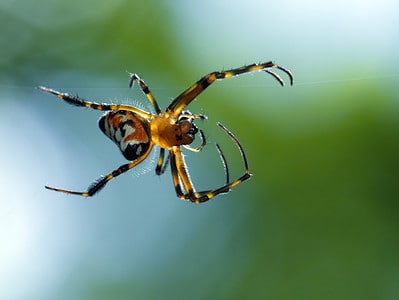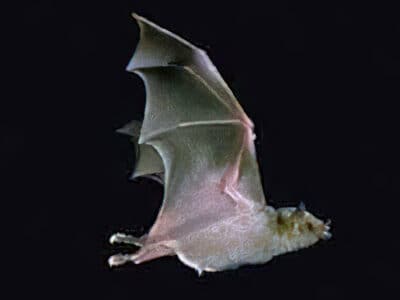Fainting Goat
Capra aegagrus hircus
These goats don't actually faint, instead they fall over due to their inability to relax their muscles after tensing
Advertisement
Fainting Goat Scientific Classification
- Kingdom
- Animalia
- Phylum
- Chordata
- Class
- Mammalia
- Order
- Artiodactyla
- Family
- Bovidae
- Genus
- Capra
- Scientific Name
- Capra aegagrus hircus
Read our Complete Guide to Classification of Animals.
Fainting Goat Conservation Status
Fainting Goat Facts
- Name Of Young
- Kid
- Group Behavior
- Herd
- Fun Fact
- These goats don't actually faint, instead they fall over due to their inability to relax their muscles after tensing
- Estimated Population Size
- 10,000
- Biggest Threat
- Predators
- Other Name(s)
- myotonic goat, Tennessee Fainting goat
- Gestation Period
- 180 days
- Temperament
- mild
- Age Of Independence
- 6 to 8 months
- Litter Size
- 1-2
- Habitat
- open pastures
- Predators
- Coyotes, bears, wolves, dogs, big cats
- Diet
- Herbivore
- Lifestyle
- Domesticated Animal
- Favorite Food
- Grass and leafy greens
- Common Name
- myotonic goat
- Origin
- Tennessee
- Slogan
- Frightening this goat will cause it to fall over in fear!
- Group
- herd
Fainting Goat Physical Characteristics
- Color
- Brown
- Grey
- Fawn
- Black
- White
- Tan
- Dark Brown
- Skin Type
- Fur
- Top Speed
- 15 mph
- Lifespan
- 10 to 12 years
- Age of Weaning
- 6 to 8 weeks
View all of the Fainting Goat images!
The fainting goat, also known as the Tennessee fainting goat, is a domestic breed of goat known for a strange mutation that causes congenital myotonia, or fainting. This reflex is caused by a genetic condition that causes the muscles to stiffen and freeze when stimulated. Although it may look painful, this condition is not harmful to goats, who usually recover quickly from fainting episodes.
5 Incredible Facts
- Fainting goats are characterized by their “fainting” episodes, which are caused by a genetic condition called congenital myotonia.
- When startled, fainting goats stiffen up and fall over, often appearing to faint. However, they quickly recover and return to normal within a few seconds.
- Fainting goats were first bred in Tennessee in the early 1800s and were initially used for meat and hide production.
- Today, an estimated 10,000 fainting goats are in the United States alone.
- Fainting goats make great pets because of their docile nature and unique appearance. They are also known to be kind animals.
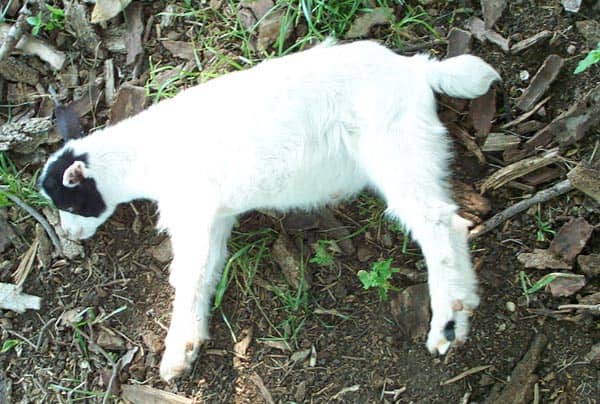
When startled, fainting goats stiffen up and fall over, often appearing to faint.
©Redleg at English Wikipedia, Public domain, via Wikimedia Commons – License
Fainting Goat Scientific Name
The scientific name for the fainting goat is the same as all other domestic goats, Capra aegagrus hircus. This name is important because it helps us understand this animal species more. Capra aegagrus hircus is the domestic form of the wild goat species Capra aegagrus. The word “hircus” means “male goat.” The fainting goat gets its common name from its tendency to faint or fall over when startled or scared. This happens because the muscles freeze under stress or excitement.
Appearance
The fainting goat is a small to medium-sized breed of domestic goat. They are characterized by their long, slender bodies and relatively short legs. Fainting or myotonic goats are usually white or cream-colored, but they can also be black, brown, or gray. Fainting goats have large protruding eyes, long, floppy ears, and a typical goat nose. Fainting goats can vary in size, color, and weight. The horns of fainting goats can vary from individual to individual. Females tend to have smaller horns. Some males have long curvy horns, while others have shorter straight horns.
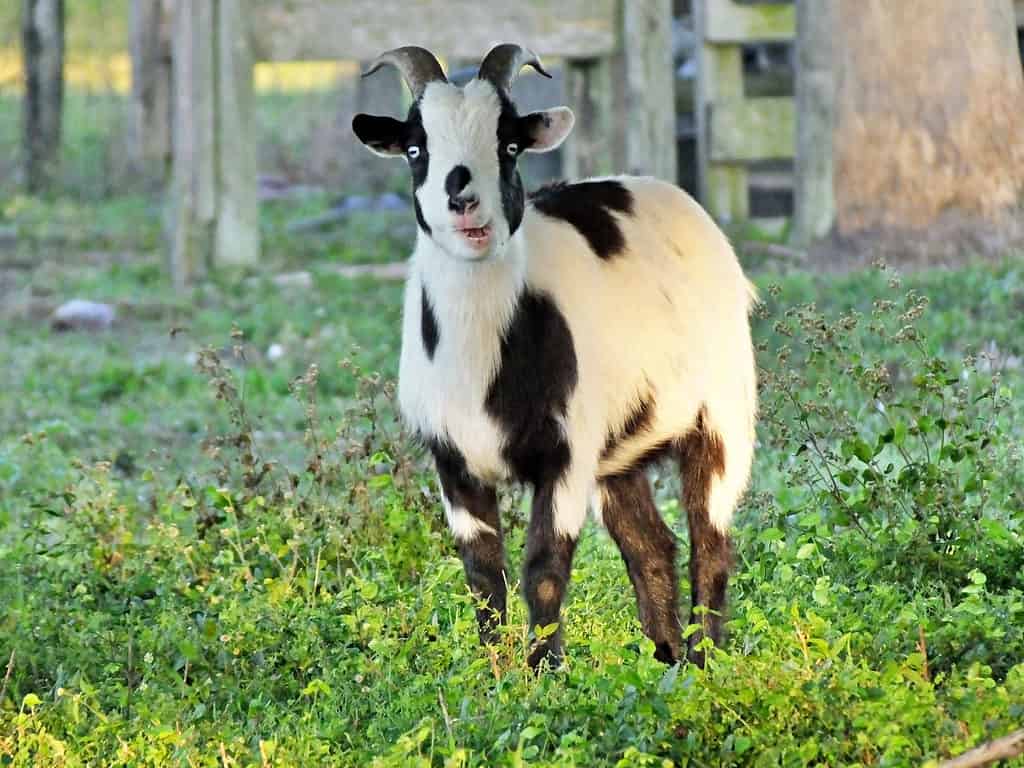
Myotonic goats are usually white or cream-colored, but they can also be black, brown, or gray.
©iStock.com/passion4nature
Evolution
The fainting goat is thought to have originated in Tennessee in the late 1800s, and there are now populations of these goats all over the world. The myotonic goat is prized for its meat and milk, and its unique appearance and condition has made it a popular pet. While there is currently no conclusive evidence as to where the fainting goats evolved from, there are two main theories. One theory suggests that the breed is descended from African pygmy goats brought to America by people in the 1600s. The other theory suggests that the fainting goat is a cross between a Tennessee landrace goat and a French Alpine goat which occurred in Europe in the early 1900s. Whatever their origins, there is no doubt that fainting goats are unique creatures with fascinating genetic mutations.
In short, this mutation causes goats to appear to faint or fall over when they are surprised because their muscles have the inability to relax quickly after tensing. Congenital myotonia also exists in some humans with similar effects as the congenital myotonia in fainting goats.
Behavior
Fainting goats are known for their unusual fainting behavior when startled or excited. However, these goats don’t actually “faint” per say. Instead they fall over due to stiff muscles. This is due to myotonia congenita, which causes muscle stiffness and delayed relaxation. When this happens, the animal’s muscles suddenly tense up, and they fall over onto their side or back. This usually lasts for only a few seconds before the animal recovers and gets back up again. While myotonic goats may look fragile, they are pretty hardy animals like most other goats. They are well suited to living in hot and cold climates and can survive on very little food and water. Myotonic goats are also relatively resistant to disease.
Despite their unusual appearance and behavior, fainting goats are popular as pets and livestock animals. They are generally gentle and good-natured, making them ideal for families with children. Fainting goats are also commonly used for their meat and their milk.
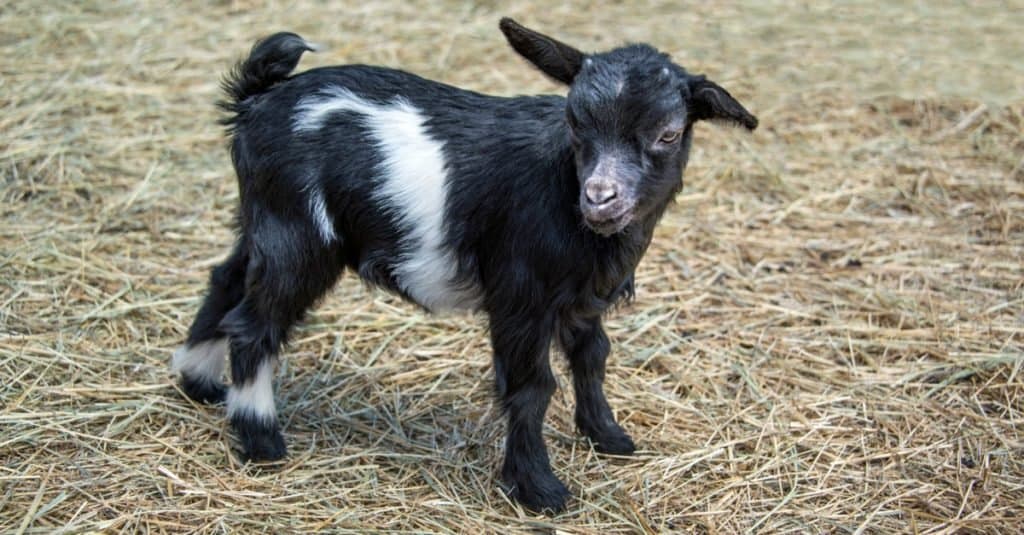
Myotonic (fainting) goats are generally gentle and good-natured, making them ideal for families with children.
©Georgia Evans/Shutterstock.com
Fainting Goat Habitat
While the fainting goat’s disorder may seem like a negative trait, it makes fainting goats very well-suited to specific environments. One of the best habitats for fainting goats is a pasture with plenty of open space. Unlike some other goat breeds, fainting goats are not good climbers or jumpers. They are relatively slow and not agile, so they do well with flat spaces.
Fainting goats need room to run and play, and they do not do well in confined spaces. They also need access to fresh water and plenty of grass or hay for grazing. Another excellent habitat for fainting goats is a farm with other animals. Fainting goats are social creatures and are best when they have companionship. They are often used as guard animals on farms because they will sound an alarm if they see anything strange or out of place. Like other goat species, they will yell out when distressed, which is usually followed by the goat falling over.
Diet
Despite their unusual condition, fainting goats are hardy animals and can thrive on various diets. They are typically grazers and prefer to eat grasses, herbs, and leaves. However, they can also do well on a diet of hay and pellets if necessary. Some of the best foods for fainting goats include grass hay, alfalfa hay, and leafy green vegetables. This diet helps to keep the goats’ muscles solid and healthy. Fruits and sweet vegetables should be avoided, as they can cause an increase in blood sugar levels which can trigger a myotonic episode. It is vital to ensure that fainting goats have access to fresh water, as they can quickly become dehydrated due to their condition. So, owners should ensure the animals get plenty of water after it faints.
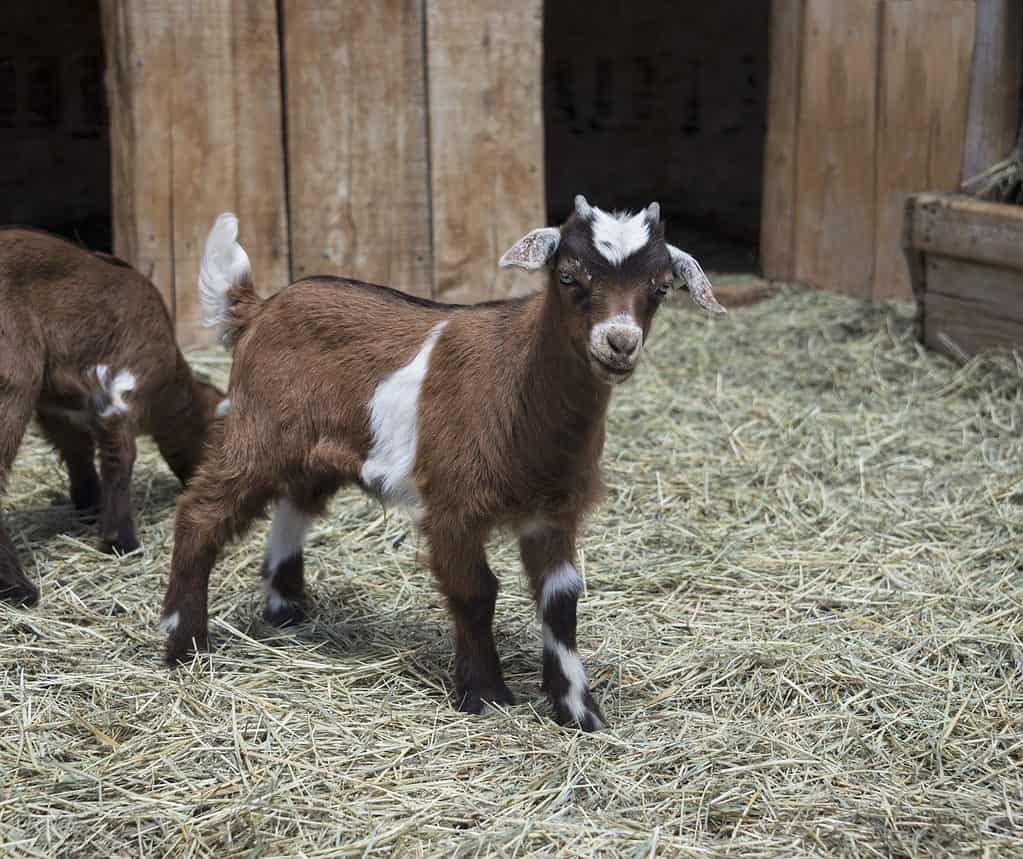
Some of the best foods for fainting goats include grass hay, alfalfa hay, and leafy green vegetables.
©iStock.com/WestwindPhoto
What eats the fainting goat?
Coyotes, foxes, dogs, and other large predatory animals can prey on fainting goat.
What does the fainting goat eat?
The fainting goat can eat various foods, including grass, hay, and leafy green vegetables. They spend most of their day grazing in open pastures.
Predators and Threats
Unfortunately, the fainting goat is susceptible to being preyed upon by many different predators. These include coyotes, foxes, dogs, bobcats, cougars, bears, and other large animals. In addition to these natural predators, humans also threaten fainting goats as the animals are bred for their meat.
Fortunately, some steps can be taken to help protect fainting goats from predation. For example, farmers and pet owners can build secure fences to keep predators out. In addition, people who live in areas where predators are present should be aware of the dangers these animals face and take precautions accordingly (e.g., not leaving fainting goats unattended near areas where wild animals may be present).
Myotonic episodes make fainting goats especially susceptible to predation as they are unable to run away if startled by a predator. This means if a predator attacks your livestock, the fainting goats are the most likely to be preyed on as they are the easiest targets.
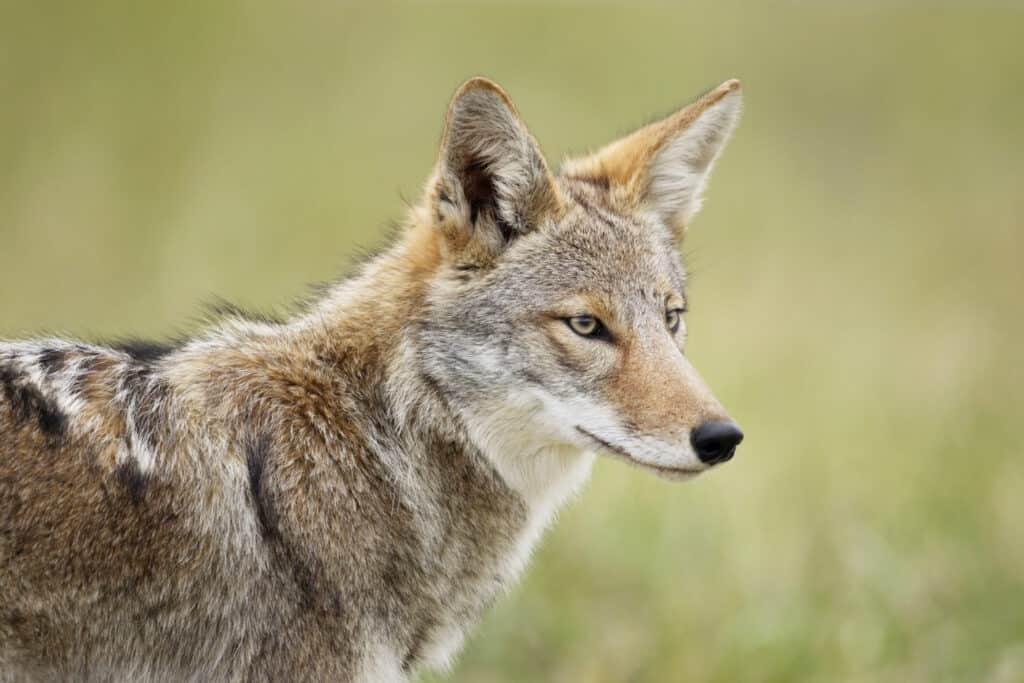
Myotonic episodes make fainting goats susceptible to predation as they are unable to run away if startled by a predator such as a coyote.
©Paul Tessier/Shutterstock.com
Fainting Goat Reproduction
The fainting goat’s reproductive system is very similar to that of other goats; however, there are some notable differences. For example, due to their myotonic gene, fainting goats often have difficulty birthing their young. This is because the muscle stiffness caused by the gene can make it difficult for the mother to push her offspring out. As a result, many fainting goats require assistance during childbirth. Additionally, because they often have smaller litters than other breeds of goat, fainting goats are also considered less productive in milk production than other goat breeds. The gestation period for the fainting goat is around 180 days. And the average litter size is 1 or 2.
Babies
Fainting or myotonic goat mothers will care for their young. Goat babies are called kids. She will clean them, keep them warm, and ensure they are safe from predators. The baby goats drink their mother’s milk for 6 to 8 weeks, at which point they will begin to eat grass and other vegetation. The kids are generally amiable creatures. They love to play and be around people. However, if they feel threatened in any way, they may try to defend themselves by kicking or biting.
Lifespan
On average, fainting goats have a lifespan of 10-12 years. However, there have been individual cases where goats have lived much longer – up to 15 years. So, if you take good care of your myotonic goat and provide them with a healthy diet and plenty of exercise, it can enjoy a long and happy life. Some threats to the fainting goat include, but are not limited to:
- Predators
- Illness
- Hunting
Population
The fainting goat breed is now considered relatively rare, but there are some estimates that there are around 10,000 fainting goats in North America. There are several reasons why the fainting goat population might be declining. One reason is that they are sometimes killed by predators such as coyotes or dogs because they cannot run away when startled.
Another reason is that they are sometimes considered a nuisance by farmers because they tend to faint (and thus be unable to escape from predators or fences). Finally, many people do not know about this unique goat breed, so they are not being bred as often as other, more widespread species. Despite these challenges, many still appreciate the fainting goat’s unique quirks and characteristics. And with proper care and protection from predators, these goats can still thrive in small herds on farms across North America.
Similar Animals
View all 91 animals that start with FFainting Goat FAQs (Frequently Asked Questions)
Are fainting goats carnivores, herbivores, or omnivores?
The fainting goat is known as a herbivore, as it mainly eats vegetation.
Are fainting goats monogamous?
The fainting goat is not commonly known as monogamous, as the males tend to mate with several different females.
Which countries are fainting goats found in?
The fainting goat is mainly found in farms and pastures in North America, as it originated in Tennesee.
What is the average lifespan of a fainting goat?
The average lifespan of the fainting goat is approximately 10-15 years.
Do fainting goats actually faint?
Despite their name, fainting goats do not actually faint. Instead, their muscles tense up, causing them to sometimes fall to the ground for several seconds.
Can you eat fainting goats?
Fainting goats are popular for human consumption and are commonly raised for their meat and milk.
Thank you for reading! Have some feedback for us? Contact the AZ Animals editorial team.
Sources
- eXtension Goat Community of Practice, Available here: https://goats.extension.org/goat-breeds-myotonic/
- Natural History Musuem, Available here: https://www.nhm.ac.uk/discover/why-do-goats-faint-and-scream.html
- National Geographic, Available here: https://www.nationalgeographic.com/animals/article/fainting-goat-fear-response-video








